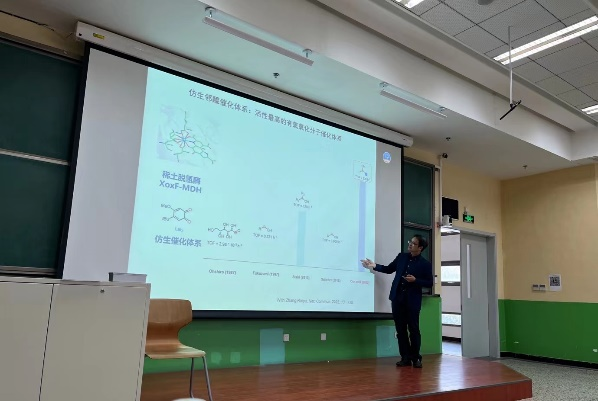At 14:00 on November 8, 2022, Professor Luo Sanzhong from the Department of Chemistry of Tsinghua University was invited by Professor Huang Hui to deliver the keynote lecture "Bionic Small molecule Catalysis: Mechanism, Data and Machine Language" in the University of Chinese Academy of Sciences. The lecture was held in Room 207 on the first floor of the teaching Hall.


Modern catalytic reaction systems are delicate and complex, and the dimensions of the catalytic process are numerous and dynamic, so it is still a challenge to clarify the catalytic mechanism, outline the structure-activity relationship of catalysis and realize rational design.


In the lecture, Professor Luo Sanzhong firstly took the research results of bionic o-quinone catalytic system, asymmetric ammonomethyl reaction and asymmetric alkyl sulfide reaction as examples, and systematically introduced the development of bionic catalytic system based on biology from three aspects: multi-functional group coordination, coenzyme simulation and mechanism simulation. Four new catalytic strategies, namely metal catalytic synergy, organic small molecule catalytic synergy, photocatalytic synergy and electrochemical synergy, were introduced. Then Professor Luo explained the mechanism and law research to the students, such as the bionic mechanism of anionic proton shuttle, using the mechanism model to help the racemization chiral synthesis path breakthrough and so on. The application of artificial intelligence in the field of molecular catalysis is also introduced, especially the SPOC descriptor and its application in the reaction of aldol catalyzed by pKa and amino group. Finally, Professor Luo Sanzhong communicated and discussed with the teachers and students on site, which was warmly responded by the teachers and students on site.


Luo Sanzhong is a professor in the Department of Chemistry at Tsinghua University. He is currently the Deputy dean of the Department of Chemistry at Tsinghua University and the director of the Center for Basic Molecular Science at Tsinghua University. He received his Ph. D. degree from the Institute of Chemistry, Chinese Academy of Sciences in 2005. From 2005 to 2018, he worked at the Institute of Chemistry, Chinese Academy of Sciences, and from 2018 to Tsinghua University. He won the Youth Chemistry Award of the Chinese Chemical Society in 2008, the Lu Jiaxi Young Talent Award of the Chinese Academy of Sciences in 2009, the National Outstanding Youth Grant of the National Natural Science Foundation in 2010, and was elected to the Youth Innovation Promotion Association of the Chinese Academy of Sciences in 2011 as the president (2011-2015), and the Youth Top Talent Grant of the 10,000 Thousand Program of the Organization Department of the Central Committee in 2012. He was awarded the May Fourth Medal of China Youth in 2014, the Chiral Youth Chemistry Award of Chinese Chemical Society in 2016, and the Physical Organic Chemistry Youth Award of Chinese Chemical Society in 2017. In 2017, he was selected as "Young and Middle-aged Leading Talents in Science and Technology Innovation" by the Ministry of Science and Technology. In 2018, he was selected as the innovation leader of the Organization Department of the CPC Central Committee. He is Deputy Director of the Physical Organic Committee, member of the Organic Chemistry Committee, member of the Photochemistry Committee and member of the Homogeneous Catalysis Committee of the Chinese Chemical Society.
